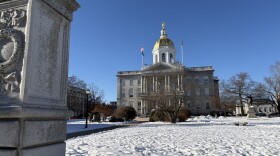Get ready for the rate shock.
This story was first published in New Hampshire Bulletin.
That’s what almost everyone who is paying attention to the price of heating fuels has been saying about the upcoming winter, and for good reason. The cost of natural gas and heating oil are skyrocketing. And since much electricity in the Northeast is generated by burning natural gas, electric rates are mushrooming, too.
Add to that the National Oceanic and Atmospheric Administration’s forecast of an unusually cold winter, and the outcome is one expensive winter for New Hampshire residents trying to heat their homes and pay their electric bills.
Households with some spare change may turn to services like weatherization that will pay off even faster given high energy costs. Others will likely look to alternative fuels, such as wood or wood chips, to keep bills down.
But low-income people, who already spend the highest proportion of their earnings on energy, will feel the crunch most acutely. The cost increases come at a time when one in five New Hampshire families already report struggling to afford usual household expenses, according to data from the U.S. Census Bureau that was collected between late September and mid-October.
The higher cost of energy is linked to inflation and other factors that extend far beyond state borders. Because American gas producers can fetch a higher price for gas abroad, that’s increasingly where they are sending it, according to Sam Evans-Brown, executive director of Clean Energy New Hampshire, a nonprofit that advocates for clean energy.
Energy prices in recent years have also been abnormally low.
“The cautionary tale here is really that we are over-reliant on a fuel that we thought was going to be at $2 per million BTU forever. And really, the story is that was an artificially low price. Now the mistaken belief that that was the norm is coming home to roost,” Evans-Brown said.
Evans-Brown is talking about natural gas, used by just over 20 percent of New Hampshire households for heat. Those households could see a 30 percent hike in heating costs compared to last year, according to the U.S. Energy Information Administration.
For the two out five homes in New Hampshire that heat with fuel oil – the most common type of heating system in the state – spending is predicted to increase by 43 percent.
“There’s nowhere else in the United States that is as reliant on heating oil as New England is. It means that these price swings are just genuinely unaffordable,” Evans-Brown said.
But neither natural gas nor fuel oil are predicted to see the biggest price jump. The 17 percent of New Hampshire households heating with propane are expected to see a 54 percent increase. About 10 percent of the state heats with electricity, and the remaining 9 percent uses some other heat source.
For Evans-Brown, the price swings for imported fossil fuels are another reason to lock in fuels that won’t vary dramatically over time: the shining of the sun, the wind moving through the atmosphere.
But while beefing up renewables could prevent this from happening in the future – as Evans-Brown sees it – there’s also the frustration of seeing policies that could help families now put on pause. That’s precisely what has happened with the state’s energy efficiency programs.
Eric Chabot has seen this firsthand. Chabot is an energy auditor for Turn Cycle Solutions, and he says about 95 percent of his business comes through the state’s energy efficiency program, New Hampshire Saves. The program offers incentives to keep down the cost of energy efficiency measures, but it’s been in a state of uncertainty since the start of the year, when a 3-year plan was supposed to take effect but didn’t because the Public Utilities Commission failed to approve it.
Chabot has found the conversation in the State House frustrating because he thinks lawmakers who oppose increased spending on energy efficiency – funded through what’s called the System Benefits Charge – are putting the interests of the state’s biggest businesses over the typical Granite Stater, for whom health and wellness hang in the balance.
For Chabot, the best part of the job is seeing people get more comfortable in their homes. “It’s hearing the dramatic impact on how people are able to use their homes and live,” he said during an energy audit on a Milford home that one of his co-workers recently purchased.
Weatherizing a home is one thing residents can do to lower their heating bills and keep their homes warmer. And that – along with a desire to use less fuel for the sake of human health and the environment – is typically why people reach out to Chabot.
When energy auditors go into a home, they’re looking for evidence of who has come before them and what they’ve done to make the house warmer. Michael Turcotte, who owns Turn Cycle Solutions, said in one 1752 house, he even found old corn cobs and newspaper stuffed in the walls as insulation. Turcotte said a typical project with the New Hampshire Saves program would cost around $4,000. An owner would usually pay around $2,000 of that, and the return on investment would take about 15 months. But if energy prices double, the return on investment might take only 7 months, he said.
As Chabot does an energy audit on a home, he’s trying to figure out how “leaky” it is – where cold air is coming in – and what he can do to improve efficiency. He starts at the top of the house and works his way down. The finale is a test called the blower door, where a powerful fan blows air out of the house to find spots where cold air is entering the house.
“I’ve certainly seen worse, but it can be improved upon,” he said of the Milford house.
While the state has put a pause on increasing energy efficiency programs, a fuel assistance program is receiving an additional $35 million in federal American Rescue Plan Act funding. Individuals who are struggling to pay their bills can apply for grants to offset the cost of any type of fuel they are using to heat their home. On Friday, the state’s fiscal committee voted unanimously to accept the money. Last year, the program served 25,000 households, and the Department of Energy estimates that its typical budget is around $25 million to $28 million, so it’s set to more than double this year.
Eligibility for the program is based on income and the size of the household; for a family of four the program is open to those earning less than $69,686 a year. The program typically pays around $889, although the amount can range between $158 to $1,575, based on family size, income, energy costs, and housing type. Those interested in signing up can apply through their local Community Action Agency.
The state’s utilities are also worried about the big bills they will be sending and the impact it’s going to have on the state’s residents. Both Liberty and Unitil said they’re thinking about how to connect customers who are having trouble paying their bills with aid programs.
“Liberty is very concerned about the increase in gas prices that is occurring across the country, as it could cause a financial hardship for some of our customers. Prices for all forms of energy are increasing this year, including electricity and propane,” according to a spokesperson for the company in a written statement.
Unitil, another of the state’s electric and natural gas utilities, called it a global supply crisis. Alec O’Meara, a spokesperson for Unitil, said the company would be offering flexible payment plans, and directing customers who are having a hard time paying to programs offered by Community Action Programs around the state.
Liberty also said there are steps customers can take “to help ease the burden of rising gas costs.” They have a budget billing program that allows customers to spread out payments over the year to flatten out seasonal fluctuations in their monthly gas bill. They offer payment arrangements for those with a past-due balance, and they have a discounted natural gas rate for households with someone enrolled in at least one eligible assistance program.
When energy prices for oil and gas go up, Scott Nichols said he often sees people turn to alternatives like wood. Nichols owns Tarm Biomass, a company that sells different kinds of wood boilers.
“The biggest driver of our sales is high oil and gas prices,” Nichols said, although he hasn’t been getting as many calls recently as he expected.
Of the $6 billion per year that New Hampshire spends on energy, much of that leaves the state because it’s spent on fossil fuels that aren’t produced. Neighboring states like Vermont have offered incentives to get residents to switch to wood, which is grown locally, in part because of the economic benefit to the local economy.
“Even places that have been saving money with their existing pellet or chip boiler will save a ton of money in a year like this,” Nichols said. “All of a sudden their payback might go down from 10 years to two years in one swoop.”
New Hampshire Bulletin is part of States Newsroom, a network of news bureaus supported by grants and a coalition of donors as a 501c(3) public charity. New Hampshire Bulletin maintains editorial independence. Contact Editor Dana Wormald for questions: info@newhampshirebulletin.com. Follow New Hampshire Bulletin on Facebook and Twitter.







